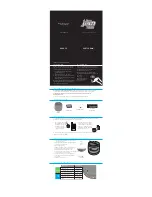
Wire
There are several manufacturers of quality speaker wire. There are various
grades and gauges (sizes) of speaker wire.
Generally, the most practical wire for the money is generically referred to
as 16/4. That means four 16 gauge insulated conductors in a single jacket
or sheath
(figure 14)
.
Why 4 Conductor?
Each room generally has two speakers (left & right); each speaker has one
(+) positive conductor and one (–) negative conductor for a total of two
conductors per speaker. That is a total of four conductors per room, hence
4-conductor wire.
Today, building codes rate speaker wire or stipulate minimum quality. At
the time this was printed a UL approved CL-2 or CL-3 rated wire was
recommended. So ask for 16/4 CL-2 or CL-3 rated UL approved wire
when you are ready to buy. Also, check if any locally applicable codes
further govern wire for sound systems.
Some people opt for 14/4 or 14 gauge. 14 gauge is thicker, will carry
higher wattages and technically does better over longer distances. We find
16 gauge to be well suited for nearly all applications. 14 gauge is more
difficult to work with at the volume control because of the tight clearances
that exist between the volume control and the inside of the J-box.
Speaker wire also comes in 2-conductor configurations.
For new construction you will only need the 4-conductor type.
For existing construction, 4-conductor and 2-conductor wires may both be
used to simplify the wiring process.
New Construction
Pre-construction brackets and J-boxes
1.
Are you going to use PRE-CONSTRUCTION BRACKETS or are you
going to cut the speaker mounting holes in the drywall after it is
installed?
Pre-construction brackets are somewhat similar to “Mud Rings” used
by electricians to mark a spot where the drywall installers are to cut a
hole.
9









































